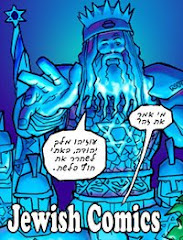
Wolfman, Marv, Mario Ruiz, and William J. Rubin.
Homeland : The Illustrated History of the State of Israel. Skokie, IL : Nachshon Press, 2007. 124 pp. $19.95. ISBN : 978-9771507-0-0 Pbk.
In 1958, on the occasion of Israel’s 10th anniversary, Thomas Yoseloff Inc. published
Pictorial History of Israel, which used over 600 black-&-white photographs (as well as a small number of black-&-white illustrations) to show readers how Israelis live and have lived, how they came to establish the modern state and how its history has been a combination of joyous triumphs and bitter struggles. Two more (updated) editions followed. However, the latest edition (published in 1968) appeared just one year after the Six Day War, on the occasion of Israel’s 20th anniversary. As useful and interesting as these books have been, there has certainly been a need for a more contemporary treatment.
Earlier this year,
Nachshon Press published
Homeland : The Illustrated History of the State of Israel. A visual panorama of images for the eyes, the book not only includes previously published photos (color photos, as well as monochrome ones which stand out on the page, due to the use of varied color backgrounds), but also contains lushly painted colored illustrations rendered by the talented comic book artist Mario Ruiz. Though the book’s authors admit to their particular viewpoint and bias early on in the narrative (which takes the form of an academic class being taught), the book occasionally introduces contrary ones (e.g. pg. 42, where a student challenges the professor by asking if Zionists had considered the rights of the Arabs who were living in the country).
One of the beautiful visual “tricks” that Ruiz uses in the book could be described as “unity of vision”. On pages 12-13, when Moses looks out towards Israel from atop Mount Nebo, what the reader sees (through his eyes) is not an ancient land of fig trees and stone wells, but a somewhat blurry modern skyline. This image is mirrored on pages 42-43, but here it is Theodor Herzl who is viewed from behind and the skyline looks a bit clearer. On pages 118-119 – the final pages of the book – the photo of the skyline is shown in focus in front of a group of young students. Another visual “trick” occurs on pages 30-31. At first glance, there appears to be a single man’s face divided along the spine of the book. However, a closer examination shows that the left side is half of a face of a Muslim, while the right side is the face of a Christian crusader.
In addition to discussing the many aspects of Jewish & Israeli life that I expected it to cover (including a condensed account of Biblical history, various periods of invasions and wars, the Holocaust, terrorism),
Homeland also touches on topics that surprised me (e.g. Shlomtzion [the first female Jewish ruler], the complexity of Zionism and its subgroups, and the explanation of the Birthright program). In my review copy, some of the text in the “1991-present” section was obscured by the photos, but I feel certain that this problem was corrected for the published editions. A newer 60th anniversary edition is planned for 2008.
Overall, I would highly recommend this stunningly visual, textually engaging book for public, school and synagogue libraries. It is well-suited for elementary students, but adults should find it worthwhile as well.







